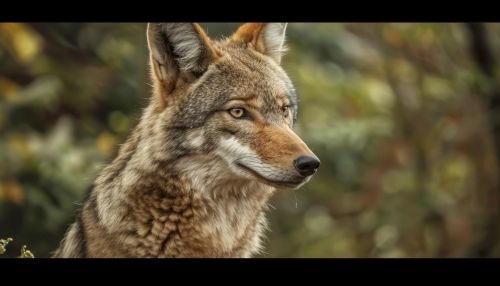Coyote
Taxonomy and Evolution
The coyote (Canis latrans) is a member of the canid family, which also includes wolves, foxes, and domestic dogs. The name "coyote" is derived from the Nahuatl word "coyotl," meaning "barking dog." The species was first scientifically described by naturalist Thomas Say in 1823 during an expedition to the western United States.
Coyotes evolved in North America during the Pleistocene epoch 1.81 million years ago alongside the dire wolf and the gray wolf. Genetic studies indicate that the coyote diverged from the gray wolf as a species less than 50,000 years ago. Unlike wolves, which underwent a drastic reduction in size, the coyote retained its size and remains one of the most adaptable and resilient predators on the continent.


Description
Coyotes are medium-sized canids, with adults typically weighing between 15 and 25 kilograms. They have a slender, elongated body, with a large, bushy tail. The fur color varies from grayish-brown to yellowish-gray on the upper parts, while the throat and belly tend to have a buff or white color. The forelegs, sides of the head, muzzle and paws are reddish-brown. The back has tawny-colored underfur and long, black-tipped guard hairs that form a black dorsal stripe and a dark cross on the shoulder area.
The coyote's skull is narrow and elongated with a slight downward bend to the muzzle. The dental formula is I 3/3, C 1/1, Pm 4/4, M usually 2/2, occasionally 3/3, 3/2, or 2/3 × 2 = 40, 42, or 44. The upper carnassials are larger and more elongated than those of the gray wolf.
Behavior
Coyotes are highly adaptable and inhabit a wide range of habitats, including prairies, deserts, forests, and even urban areas. They are primarily nocturnal but can be active during the day, particularly at dawn and dusk.
Coyotes are known for their intelligence and adaptability. They are solitary creatures but can form transient packs to hunt larger prey. Their diet is varied and includes small mammals, birds, reptiles, insects, fruits, and carrion. They are also known to eat livestock and pets, which often brings them into conflict with humans.
Coyotes communicate through a series of yips, barks, and howls. Their vocalizations serve various purposes, such as maintaining social cohesion, expressing dominance, and warning of danger. They also use body language to express dominance or submission and scent marking to mark their territory.
Reproduction
Coyotes are monogamous, and pairs remain together for several years. Breeding season occurs once a year in late winter or early spring. After a gestation period of 60 to 63 days, the female gives birth to a litter of three to twelve pups. Both parents participate in the rearing of the pups, which are weaned at about six weeks of age and begin to hunt with their parents at around three months.
Human Interactions
Coyotes have a complex relationship with humans. They are often viewed as pests due to their predation of livestock and pets. However, they also play a vital role in ecosystems by controlling rodent populations.
In Native American folklore, the coyote often plays the role of trickster, demonstrating both cleverness and foolishness. In modern times, the coyote has been the subject of various research studies due to its adaptability to urban environments.
Conservation
Coyotes are not currently considered a threatened species. They have a wide range and a large population, and they are adaptable to many habitats, including urban and suburban areas. However, they face threats from habitat loss and persecution due to conflict with livestock and game management.
